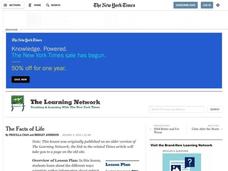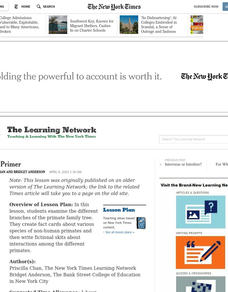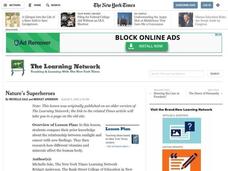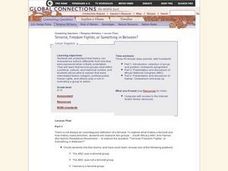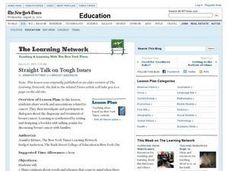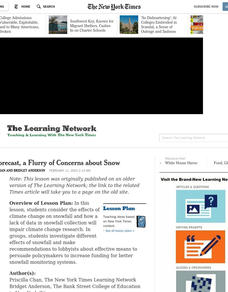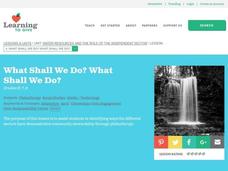Curated OER
Where Do Animals Come From?
Learners use library search engines to research an animal and its origin. In this animal research lesson plan, students research their assigned animal using ProQuest. Learners then find the country of origin of the animal using a library...
Curated OER
Soul Food
Students identify foods that they associate with different cultural groups in which they are members and speculate possible connections between specific foods and the cultures in which they are popular. They also explore the importance...
Curated OER
The Facts of Life
Students explore the different ways scientists gather information about extinct animals. They utilize these methods to create illustrated story books about a particular extinct animal.
Curated OER
Primate Primer
Students examine the different branches of the primate family tree. They create fact cards about various species of non-human primates and then write fictional skits about interactions among the different primates.
Curated OER
Government Gripes
Students, in groups, investigate the purpose and jurisdiction of government agencies assigned to regulate different science/technology/health issues, then describe situations in which agencies might have a disagreement, and stage a mock...
Curated OER
Fur Right or Wrong
Students explore the uses for animals in different societies. Then, through research and reflection, students prepare for a mock convention for animal rights. They write a letter to a governmental animal regulatory body.
Curated OER
Performance Poppers
Students examine the controversies surrounding the use of performance-enhancing supplements in sports by interviewing athletes and writing feature articles that compare the skills required to compete in different sports.
Curated OER
Frighteningly Fabulous Festivals
Students explore the significance of holiday foods, first by researching Halloween-type festivals from around the world, and then by reporting on foods related to different holidays celebrated in their homes.
Curated OER
Nature's Superheroes
Students compare their prior knowledge about the relationship between sunlight and cancer with new findings. They research how different vitamins and minerals affect the human body.
Curated OER
Guess Who's Coming to Dinner
Students create Thanksgiving menu and pre-dinner blessing or ritual that is sensitive to five different imaginary Thanksgiving guests from a variety of backgrounds.
Curated OER
Terrorist, Freedom Fighter, or Something in Between?
High schoolers identify that history can characterize actions differently from how they were perceived when initially undertaken. Then they identify that terrorist groups exist within a political, cultural, and historical context, and...
Curated OER
Making Prehistory
Students create mock fossil records based on current scientific theories about prehistory. By learning about what fossil records teach us about different prehistoric time periods, students gain a greater understanding of theories of...
Curated OER
Historical Perspective
Students research the different perspectives of important groups and figures involved in the American Revolution and apply their findings to write and perform monologues depicting this pivotal time in history.
Curated OER
Atmospheric Pressures
Students research past, present and proposed climate change policies. They develop timelines based on different predictions of climate change effects and assess the likelihood of each timeline playing out in reality.
Curated OER
Technically Speaking
Young scholars research how various forms of technology have changed during different time periods and the ways in which technology impacts society. They propose designs for galleries within a technology museum.
Curated OER
Who Gives a Hoot?
Students look at owl migration and its impact on the environment and the food chain after reading an article from The New York Times. Students then apply this information to and research different food chain situations for other species...
Curated OER
Tangled Text
Students list different forms of communication, assess importance of writing, read and discuss article "String, and Knot, Theory of Inca Writing", research system of writing, and create "How It Works" posters.
Curated OER
Straight Talk On Tough Issues
Students engage in a lesson plan that is focused upon the concept of breast cancer and research is conducted using a variety of reference sources. They reflect upon how different people deal with the tragedy of cancer and then students...
Curated OER
In the Forecast, a Flurry of Concerns about Snow
Students consider the effects of climate change on snowfall and how a lack of data in snowfall collection impair climate change research. They, in groups, investigate different effects of snowfall and make recommendations to lobbyists.
Curated OER
Suitable Schools
Young scholars explore education requirements for different professions, and define the skills and knowledge that adults use in their everyday lives. They define and describe what students, teachers and parents expect from formal schooling.
Curated OER
Plasma 101
Learners examine the definitions and characteristics of plasma. After reading an article, they analyze new technologies to study plasma. In groups, they create a poster on how the different types of plasma work and write letters to their...
Curated OER
The Social and Economic Impact of Wildlife and Natural Resource Management
Students develop an understanding of environmental laws and regulations. In this research instructional activity, students utilize information that involves controversial issues of wildlife and society.
Curated OER
Abenakis Before Contact: Different Worlds Meet
Students study the lives of the Abenaki before contact with Europeans and how their lives changed after contact with the Europeans.
Curated OER
Water Resources and the Role of the Independent Sector
Learners explore how water conservation is influenced by the four sectors of economy. In this social studies economics instructional activity, students brainstorm problems and solutions related to water conservation. Collages are...


